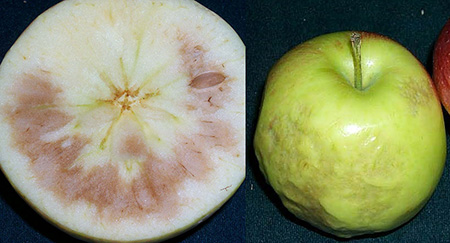Harvesting apples in the heat
The starch iodine test doesn’t tell the whole story.

We are beginning to assess the maturity of some of the traditional “October” apples in the Michigan State University Apple Maturity Program. I have been surprised by the high starch index of some of these varieties that we normally do not expect to see ripening for another two to three weeks (e.g., Red Delicious, Cortland, Mutsu). The ethylene levels, however, are very low—in the parts-per-billion range! This suggests to me that, unlike our earlier apples like Honeycrisp and Gala, which should be headed out of the orchard in the southern half of Michigan, the later varieties are suffering from heat-based dilution of the starch.
Often during warm fall periods, the leaves have to feed the respiratory machinery that keep the tree alive and so there is less carbohydrate that makes its way into the fruit. This effect is exaggerated when the nights are warm. At that time, there is no photosynthesis to feed all the metabolic processes within the tree, so the tree takes the carbohydrate where it can find it. As a result, the fruit mobilizes its carbohydrate reserves (starch) and what we then find is a high starch index. The fruit appear to be more mature than they really are under these circumstances.
That being said, warm periods should have us concerned—fruit ripen faster at higher temperatures too, so when they are mature, they need to be harvested in a timely manner. The diluted starch problem is why we try to take several measures of apple maturity, and that includes firmness, background color and percent red color. Another measure I use informally is the tackiness of the fruit. Fruit tend to produce oils that can make them greasy, but in its early stages, simply makes the fruit tacky. These measures (and, in the lab, internal ethylene) help to generate a more complete picture of the maturity status of a given variety in your particular growing environment. Try to use as many measures as you can to get it right.

Harvesting warm fruit has a couple unwanted side effects. One is that the fruit have more heat to remove and take a little longer to cool. Another more worrisome issue for some varieties is the rapid production of carbon dioxide (CO2) from warm fruit that are of advanced maturity. They can cause CO2 to accumulate in the storage atmosphere even when the controlled atmosphere (CA) system is not operating. Varieties like Honeycrisp, Empire and Fuji tend to be pretty sensitive to CO2 in the days immediately following harvest, so monitoring CO2 or scrubbing CO2 during room loading should be considered as options to prevent CO2 injury.
Finally, remember that if the CO2 level is high, the oxygen level is low. Most apple storage rooms can be considered confined spaces and while 16 percent O2 may not harm a person directly, it can make them woozy, especially if they have compromised lung capacity. So be careful out there. Inexpensive O2 portable monitors should be standard equipment in apple storages and used to keep folks safe.



 Print
Print Email
Email